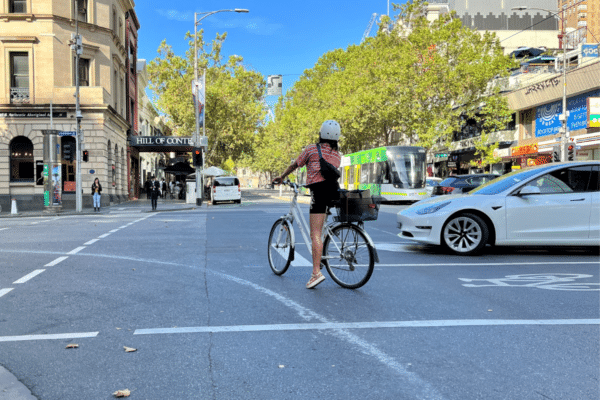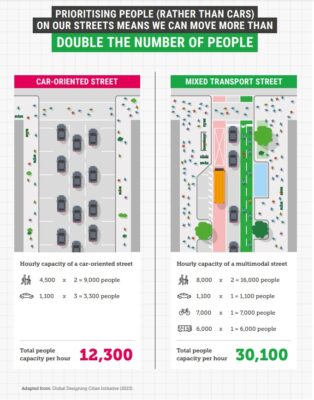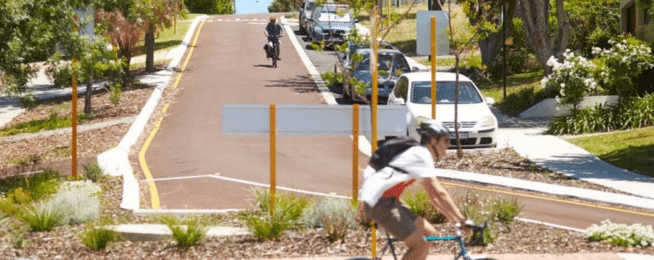There's carbon capture technology and nuclear fusion. Long-range electric vehicles and off-shore wind turbines. Many solutions to climate change remain far off in the distance with lots of unanswered questions, but the good news is we have tools at our disposal today to make a real and lasting impact.
It just requires a shift in our thinking.
That's the overarching argument of a newly published Climate Council report, which urges a dramatic uptake in bike riding, walking and use of public transport to steer Australia away from a deeply ingrained car-centric culture.
The "Shifting Gear: The Path to Cleaner Transport" report puts personal transport under the microscope, and lays out the types of emissions reductions we can achieve by reducing our reliance on private vehicles.
"Bikes offer an incredible shortcut for action on climate change" says Bicycle Network CEO Alison McCormack. "We need act now to reimagine our transport network now for today, and tomorrow."
A nation of drivers
The transport sector currently makes up 19% of Australia's carbon emissions, and is projected to go from our third to our largest source of emissions by the end of this decade.
Cars and light commercial vehicles make up 62% of those transport emissions, and are one of our fastest growing sources.
Between 1955 and 2013, the number of passenger vehicles registered in Australia ballooned from 1.4 million to 13 million. Across the nation today, there are 20.1 million registered vehicles and just 18.7 million people licensed to drive them.
The numbers of bigger and higher polluting SUVs have more than doubled in popularity in the last decade, aided by tax incentives, and account for around half of the cars sold in Australia in 2022.
"In the 1970s it was unusual for households to have more than one car, if they had a car at all," says Climate Councillor Andrew Stock. "The number of cars has increased and governments are making investments to support private car usage as a transport mode, rather than investing in active (bike riding and walking) and public transport."
Australia spends the fourth most of any OECD nation on its roads, exceeded only by the US, Japan and Germany.
These factors have cultivated a transport system built around cars. In Melbourne where half of all weekday trips are less than 4.7km, 41% take place in a car. More than two million car trips taken in Sydney every day are less than 2km. 81% of people in Australia make their daily commute in a private vehicle.
So when it comes to ways we can rein in Australia's carbon emissions, those produced through personal transport appear ripe for the picking.
An express route for climate action
While electric vehicles are growing in popularity and are an important piece of the puzzle, their impact will be gradual. According to the Climate Council's report, only 4% of our vehicle stock is replaced each year, so converting to a fully electrified fleet will take decades.
It would also be heavily tied to a decarbonisation of the grid. A Tesla Model S powered by the Victorian grid in its current form emits 209.1 grams of CO2 per kilometre travelled, while an average Victorian car emits 243.8 grams.

The government has set a national emissions reduction target of 43% by 2030 from 2005 levels, but we need to do more than turn to electric vehicles to meet this.
The Climate Council's report models a few of the pathways forward.
Under the "status quo" scenario, we can expect to see a 34% increase in overall transport emissions by 2030.
Under a "strong action" scenario, cars would make up 43% of the transport mix, rather than 81%. Active travel would rise from 5% to 17%, and public transport from 14% to 40%. This would reduce personal transport emissions by 43%.
The "transformational and equitable action" scenario involves a 75% personal transport emissions reduction from 2005 levels. This is the action required for Australia to play its part in limiting global temperature increases to 2°C above pre-industrial levels.
Under this model, cars would make up just 36% of the transport mix, active transport would rise to 15% and 49% of trips would be taken on public transport. The Climate Council says we can achieve transformational change by more than halving private car usage, tripling active transport methods and increasing public transport trips by 3.5 times.
Sounds great, but how?
The Climate Council outlines a few key ways people in Australia can be encouraged to take up active and public transport. It also recommends development of a National Transport Decarbonisation Plan to guide the journey.
We'd need to reimagine urban planning to focus on moving people rather than cars and develop mixed transport streets that greatly increase the total people capacity per hour.

Other measures include building more separated and connected bike networks with minimal missing links, better integrating bike travel with bus services and creating safer streets with more 30 km/h speed limits.
The report calls for 50% of transport budgets to be dedicated to public transport with the goal of full electrification, and 20% to go towards active transport, increasing dramatically from the 2% or less most governments spend today.
"The most important thing is for governments to understand that converting the car fleet to an electric fleet is not going to solve the problem," says Stock. "This work shows that the only way to meet these emissions reductions targets is to shift dramatically to much more active and public transport. That's the only way transport emissions are going to come close to government targets."
The UN has called on countries to invest at least 20% of their transport budgets in walking and bike infrastructure to combat climate change and disease driven by motorised transport.
"We know there is no time to waste when it comes to fighting climate change, and this report presents some powerful opportunities to make real and rapid change," says McCormack. "The message is clear, immediate investment in active transport is needed not just to improve the health of our people, but to sustain the health of our planet."


